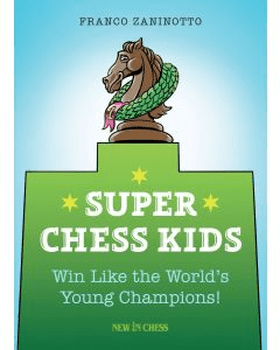| Nivå | B-C |
| Utgivelsesdato | Januar 2018 |
| Forfatter | |
| Pris | 180 NOK |
Super Chess Kids
Win Like the World's Young ChampionsEn inspirerende treningsbok for mellomnivået i sjakk, med partistillinger fra unge spillere som eksempler. Halve boka er strategi, med bl.a. svakheter og stillingsbedømmelse som nyttige temaer og den siste halvdelen med taktikk, angrep og forsvar.
Det meste av boka er stillinger å løse selv, fulgt av gode kommentarer og forklaringer fra forfatteren til løsningene. Uansett boktittel er også denne boka egentlig aldersuavhengig, og ikke noe for alminnelige barnesjakkspillere. Vi tror den vil gi verdifulle impulser og trening aller mest til ratingnivå cirka 1100 - 1900.
"Kids" i denne boka er altså unge, men stort sett svært sterke spillere som har hatt suksess i de yngste mesterskapsklassene internasjonalt, under 14 år, under 12 år, under 10 år og til og med under 8 år. ...
Forlagets egen omtale:
Zaninotto teaches elementary strategy and tactics by using games he has selected from recent Junior Championships all over the world. He shows that you don’t need to have decades of experience in order to play clever moves.
Super Chess Kids tells you all you need to know about recognizing and exploiting weaknesses in your opponent’s position. You will learn how to evaluate your position, develop a plan, and calculate moves of attack and defence. You will also see typical errors that even the best young players tend to make.
In the process you get to know players who may be members of the world elite in the not-so-distant future. Included are more than 100 strategic and tactical exercises. There is little excuse for not finding the winning moves: after all, other kids already did!
Franco Zaninotto is an Italian FIDE Master and chess trainer who has worked with talented youngster in various countries.
Fra forordet:
Dear reader,
The aim of this book is to improve your understanding of the game and your practical skills. By reading the book, you’ll see that almost all diagrams are exercises. Please try to answer the question after the diagram. Active learning is a must if you want to improve.
This book has only junior games (from under 8 to under 14). It has two parts, namely ‘Strategy’ and ‘Tactics’. Each part has five chapters, three of which have a theme, some theory and several illustrative games with exercises. The chapters on strategy (positional play) discuss ‘Weaknesses’, ‘Piece play’ and ‘Evaluating the position and planning’. Those on tactics discuss ‘Calculation’, ‘Attack’ and ‘Defence’. I assume that you have already an, albeit general, knowledge of strategic and tactical principles. There is a test at the end of each part with a set of positions to solve.
If you are a junior, I suggest that you look at this book as a challenge. Up to now, you have probably only looked at games played by masters when reading other books. Guessing the best move was undoubtedly a bonus for you. Now, it is different. The games in this book have been played by juniors in your age group. Guessing the best move now becomes a must.
If you are a chess instructor, this book will help you to identify typical mistakes made by juniors, and it will give you some tips to correct them. It also makes available interesting examples to show them.
I trust that the way chess is explained in this book will be easy to understand. Generally, a good understanding of what weaknesses are is essential, while good piece play is necessary to exploit weaknesses. Material, time and space are important if they are useful to create and exploit weaknesses. Strategy must produce weaknesses in the opponent’s camp, and tactics must exploit them. Hence, everything revolves around weaknesses.
We may have a good understanding of weaknesses, and still not achieve the desired result! Often we lose not for a lack of knowledge, but because we are unable to use our knowledge. Typical situations are: blundering a piece, not seeing the best move, not seeing a threat, and losing on time. In every situation, there was a weakness (the chess clock is the 33rd piece). We had the knowledge to identify and exploit it, but we didn’t do it. Why does this happen? Because we have to improve our way of thinking. This book provides some tools for doing this.
Franco Zaninotto, Milan, December 2017
PDF-utdrag| Innbundet? | Nei |
| Type | Bok |
| Språk | Engelsk |
| Antall sider | 139 |

